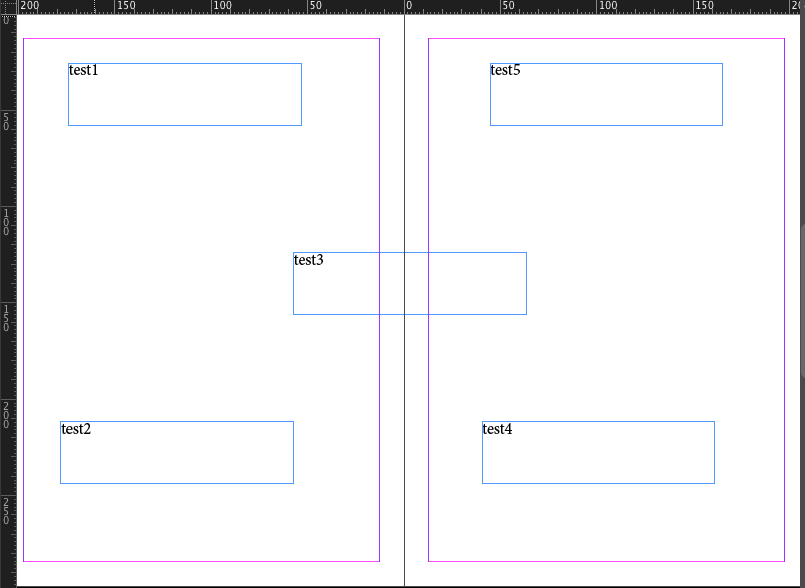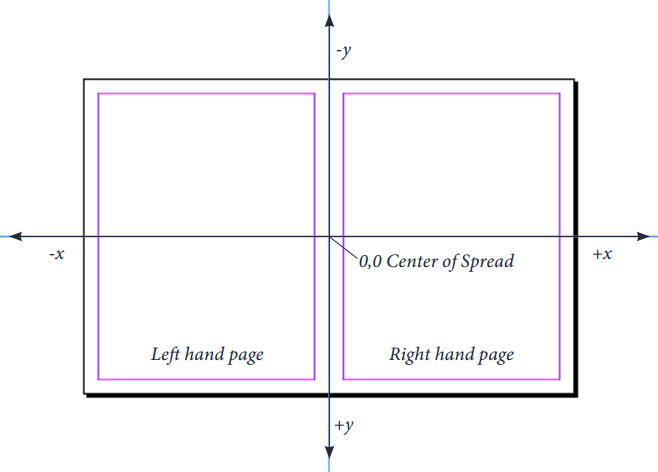IDML是Adobe开发的桌面出版软件InDesign使用的文件格式,基于XML,由INX发展而来。INDD是现在版本InDesign的默认格式,导出IDML可以供旧版InDesign使用。
因为IDML基于XML,可以较为方便的为其它软件读取,并自动进行文件生成和处理。开源的DTP工具Scribus在1.5版中添加了对IDML的支持。而主流的CAT软件也都支持翻译IDML文件。
关于IDML的具体信息,可以参见Adobe Indesign CS6 SDK的相关文件:
- IDML Cookbook: http://wwwimages.adobe.com/content/dam/acom/en/devnet/indesign/sdk/cs6/idml/idml-cookbook.pdf
- IDML Specification: http://wwwimages.adobe.com/content/dam/acom/en/devnet/indesign/sdk/cs6/idml/idml-specification.pdf
- 完整的SDK:https://www.adobe.com/devnet/indesign/sdk/eula_cs6.html
相关概念
一些InDesign中使用的术语:
Spread:一个对页,可以由1到n页组成。一般是两页。创建文件时,需要勾选facing pages来启用两页一个对页的模式。
Story:文字框中的文本。
示例
我们这里新建一个5页的Document,使用对页,然后在第二、三页上画5个文字框,然后导出为IDML。

IDML文件是一个zip压缩的文件夹,里面包含了功能不同的xml文件。解压IDML,可看到文件的结构如下:
.
├── META-INF
│ ├── container.xml
│ └── metadata.xml
├── MasterSpreads
│ └── MasterSpread_udd.xml
├── Resources
│ ├── Fonts.xml
│ ├── Graphic.xml
│ ├── Preferences.xml
│ └── Styles.xml
├── Spreads
│ ├── Spread_uc8.xml
│ ├── Spread_uce.xml
│ └── Spread_ucf.xml
├── Stories
│ ├── Story_u106.xml
│ ├── Story_u11d.xml
│ ├── Story_u134.xml
│ ├── Story_u151.xml
│ └── Story_ued.xml
├── XML
│ ├── BackingStory.xml
│ └── Tags.xml
├── designmap.xml
└── mimetype
我们需要关注的是designmap.xml、Stories和Spreads。
designmap.xml包含了一个Document标签,里面又用idPkg标签包含了spreads、stories和resources里的各种设置文件。
导出的idml里的内容很啰嗦,其实一个简单designmap.xml只需以下内容(例子来自cookbook):
<?xml version="1.0" encoding="utf-8"?>
<?aid style="50" type="document" readerVersion="6.0" featureSet="257"?>
<Document
xmlns:idPkg="http://ns.adobe.com/AdobeInDesign/idml/1.0/packaging"
DOMVersion="7.0" Self="d">
<idPkg:Spread src="Spreads/Spread_spread1.xml"/>
<idPkg:Story src="Stories/Story_story1.xml"/>
</Document>
然后是stories文件,内容也很简单。其中Self属性可以便于不同文本框引用同样的内容。
<?xml version="1.0" encoding="utf-8"?>
<idPkg:Story xmlns:idPkg="http://ns.adobe.com/AdobeInDesign/idml/1.0/packaging"
DOMVersion="7.0">
<Story Self="story1">
<Content>Hello World!</Content>
</Story>
</idPkg:Story>
如果Content是页码,对应的内容是<?ACE 18?>。
最后是Spread文件:
<?xml version="1.0" encoding="utf-8"?>
<idPkg:Spread xmlns:idPkg="http://ns.adobe.com/AdobeInDesign/idml/1.0/packaging"
DOMVersion="7.0">
<Spread Self="spread_1" PageCount="1">
<TextFrame Self="textframe1" ParentStory="story1" ContentType="TextType" ItemTransform="1 0 0 1 -612 -396">
<Properties>
<PathGeometry>
<GeometryPath PathOpen="false"> <PathPointArray>
<PathPoint Anchor="36 36" LeftDirection="36 36" RightDirection="36 36"/>
<PathPoint Anchor="36 186" LeftDirection="36 186" RightDirection="36 186"/>
<PathPoint Anchor="172 186" LeftDirection="172 186" RightDirection="172 186"/>
<PathPoint Anchor="172 36" LeftDirection="172 36" RightDirection="172 36"/>
</PathPointArray>
</GeometryPath>
</PathGeometry>
</Properties>
</TextFrame>
</Spread>
</idPkg:Spread>
其中PageCount代表这个对页里有多少页,TextFrame里的ParentStory对应的使用的Story的ID。注意,这里TextFrame出现的顺序是按生成TextFrame的顺序来的,不是页面中从左上到右下这样的位置顺序。
IDML里的定位(geometry)比较复杂,有ItemTransform和PathPoint这些概念。首先,idml里是以中心为原点的,如下图所示:

坐标是ItemTransform属性中后面的两个数值,分别是x坐标和y坐标。而前面的1 0 0 1表示方向。而PathGeometry的内容则定义了形状的大小。
以上只是大致的介绍,在上面列出的资料中有更详细的说明。